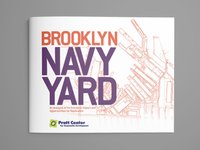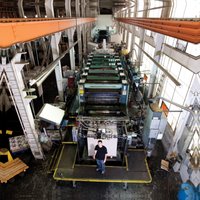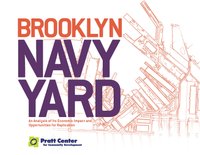
In this report, Pratt Center presents a thorough investigation of the Brooklyn Navy Yard (BNY), a 300-acre city-owned industrial park and one of the fastest growing green manufacturing centers in the country. The paper demonstrates that New York City’s strategy of retaining ownership of the Navy Yard, placing it under mission-driven, nonprofit management and investing a total of $250 million in capital funds since 1996 has paid off: the Navy Yard generates $2 billion in economic output and sustains 10,000 jobs and $390 million in earnings each year.
The report provides analysis that can help other cities strengthen their manufacturing sectors by replicating all or part of the Navy Yard model; Philadelphia, Chicago and Detroit are examined. Recommendations are offered for strategies that federal, state and city governments can implement to help private and nonprofit developers acquire and renovate older industrial buildings and make them attractive to today’s modern urban manufacturer.

Revitalizing American manufacturing is increasingly recognized by leaders across the political spectrum as a core economic strategy to create well-paying jobs and spur economic growth. Cities throughout the US are testing new and varied ways to advance these objectives, and NYC’s Brooklyn Navy Yard (BNY) is one such example.
In an effort to learn more about the BNY and its economic impact, and identify tangible and replicable factors that contribute to its successful functioning, Pratt Center organized an extensive research initiative. For this project, we conducted in-person interviews with board members, staff members, BNYDC executives, and elected officials for information on the history, management, current operations, and political context of the BNY. We also collected detailed information about current tenants through a survey administered over the course of several months.

Findings
- We found that the BNY’s economic output for 2011 was $1.93 billion, and was responsible for 10,350 direct and indirect jobs and $392 million in earnings.
- This economic activity in turn induced another $1.96 billion in earnings and an additional 15,500 jobs.
- The BNY also contributes construction-related, economic impacts that vary from year to year depending on construction activity. In 2011, BNY construction activity was responsible for $100 million in economic activity, 454 direct and indirect jobs, and over $21 million in earnings.
- These annual impacts are expected to grow significantly in the coming years as new developments come on line, and by 2015 are expected to increase to $2.35 billion in recurring annual output; over 30,000 direct, indirect, and induced jobs; and $2.37 billion in induced additional earnings.
Recommendations
We also identified cities where the BNY model could be replicated. We focused specifically on Philadelphia, Chicago, and Detroit in order to showcase a range of increasing/decreasing population, geography, and existing elements of the BNY model. In addition to city-specific recommendations for these three cities, our project also offered general recommendations that governments at all levels can use when looking for ways to nurture and expand a nonprofit industrial development sector. These include:
- establishing an “Industrial Development Fund” for nonprofit acquisition and development of industrial space;
- considering net leasing publicly owned industrial sites, rather than selling them outright;
- encouraging partnerships between for-profit and nonprofit developers;
- adapting traditional economic development tools such as tax credits, loan guarantees or other credit enhancements, and bonds so that developers of industrial rental space are eligible; and
- aligning zoning and land-use policies and infrastructure investments to advance economic development strategies.
